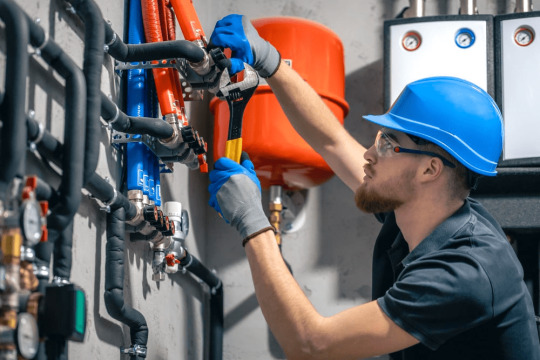Don't wanna be here? Send us removal request.
Text
Water Damage Repair and Restoration: What You Need to Know

Water damage is one of the most common and costly issues property owners face. Whether caused by a burst pipe, severe weather, leaking appliances, or flooding, the effects can be devastating if not addressed promptly. Water can weaken structures, ruin personal belongings, and create the perfect environment for mold growth. Understanding how water damage repair and restoration works—and why a timely response is essential—can help you protect your property and health.
What Is Water Damage?
Water damage occurs when excess water infiltrates a structure and causes harm to materials, finishes, and even the integrity of the building. It ranges from minor leaks to major flooding events. The source of the water significantly affects how restoration is handled. Water is generally classified into three categories:
Category 1: Clean water from sources like broken water supply lines or overflowing sinks.
Category 2: Gray water containing contaminants, such as from washing machines or dishwashers.
Category 3: Black water, which is highly unsanitary and comes from sewage backups, storm floods, or standing water with microbial growth.
The category of water impacts the urgency, safety measures, and methods used in the restoration process.
Common Causes of Water Damage
Understanding the common causes can help you prevent or respond more effectively to water damage. These include:
Plumbing issues: Burst pipes, pipe leaks, or faulty plumbing systems.
Appliance malfunctions: Leaks from washing machines, water heaters, refrigerators, or dishwashers.
Roof damage: Missing shingles, clogged gutters, or roof leaks allow rainwater to seep in.
Severe weather: Heavy rains, snowmelt, hurricanes, and flooding.
Foundation cracks: Water can enter through cracks in walls or floors, especially in basements.
Identifying the source quickly is the first step toward a successful repair.
The Water Damage Restoration Process
Water damage restoration is a structured process that includes several steps. Professionals follow industry standards (like those from the IICRC) to ensure thorough and safe restoration.
1. Inspection and Assessment
The restoration team begins with a comprehensive inspection to determine the extent of the damage. Using moisture meters, infrared cameras, and other tools, they locate all areas affected by water—even those not visible to the naked eye.
2. Water Removal
Using industrial-grade pumps and vacuums, professionals extract standing water from floors, carpets, and other surfaces. The quicker this step is completed, the lower the risk of mold and secondary damage.
3. Drying and Dehumidification
After visible water is removed, the next step is drying the area thoroughly. High-powered air movers and dehumidifiers are used to remove moisture from walls, floors, and air. This process can take several days depending on the extent of the water exposure.
4. Cleaning and Sanitizing
Water-damaged materials are cleaned and sanitized to prevent bacterial or fungal growth. This includes antimicrobial treatments, odor removal, and air scrubbing if necessary. Items like carpets, upholstery, and personal belongings may be restored or discarded depending on contamination.
5. Restoration and Repairs
The final step involves repairing or replacing materials like drywall, flooring, and insulation. In some cases, major reconstruction is required, especially if there was structural damage. Restoration aims to return the space to its pre-loss condition, both functionally and aesthetically.
Why Timely Response Matters
Time is critical when it comes to water damage. The longer water remains, the greater the risk of mold, structural issues, and permanent damage to your belongings. Here’s what typically happens over time:
Within hours: Water spreads quickly, soaking into floors, walls, and furniture.
Within 24-48 hours: Mold can begin to develop, especially in warm or humid conditions.
Within a week: Serious structural damage may occur, and mold colonies can grow rapidly.
After a week: Restoration becomes more expensive, more invasive, and more time-consuming.
Quick action reduces damage, lowers costs, and helps protect your health.
The Dangers of Mold Growth
Mold is a major concern following water damage. It thrives in moist environments and can begin growing within 24 to 48 hours of water exposure. Mold not only damages building materials but also poses serious health risks, particularly to people with respiratory issues, allergies, or weakened immune systems.
Professional restoration includes mold detection, containment, removal, and prevention. This ensures that your property is safe and healthy after the water damage is repaired.
Do You Need a Professional?
While some minor water damage incidents can be handled with DIY tools, most situations—especially those involving contaminated water, large volumes, or hidden moisture—require professional help. Restoration companies have the tools, training, and experience to:
Identify hidden damage
Dry and sanitize effectively
Prevent mold growth
Provide documentation for insurance claims
Attempting to handle significant water damage without professional help can result in incomplete drying, hidden mold, and ongoing structural issues.
Preventing Future Water Damage
While not all water damage is preventable, many incidents can be avoided with proper maintenance and preparedness:
Inspect and maintain plumbing regularly
Clean gutters and downspouts to prevent roof leaks
Ensure proper drainage around your home’s foundation
Install sump pumps and backflow valves in flood-prone areas
Use water leak detectors near appliances
Investing in prevention saves time, stress, and money in the long run.
Conclusion
Water damage repair and restoration is a critical process that protects your property, your belongings, and your health. Whether caused by a storm, plumbing issue, or appliance failure, water damage should never be ignored. Acting fast and trusting trained professionals ensures the restoration is done right—completely, safely, and efficiently.
Understanding how the process works, the risks of delay, and the importance of thorough drying and cleaning can make a major difference when disaster strikes. Being prepared and informed is your best defense against future damage.
1 note
·
View note